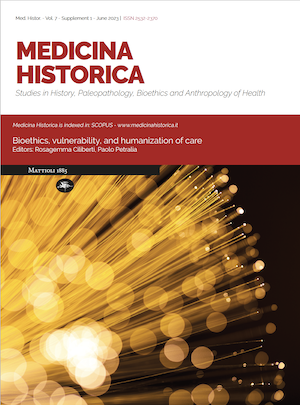To heal and take care: medical micropigmentation and its role in improving body image
Keywords:
micropigmentation, tattoo, humanisation, medical micropigmentation, reconstructive surgery, camouflage, to care, holistic medicine, dermal pigmentationAbstract
The practice of tattooing dates back to a remote past and is characterised by its many different purposes. However, in the last decades, such practice has become a cultural phenomenon, extending its reach to a broader population, including adolescents.
More recently, in the perspective of enhancing a broader therapeutic approach, heedful of the many different needs of the individual, the practice of micropigmentation has become widespread in the medical field in order to offer the possibility of reconstructing the body image where skin, pathological manifestations, and congenital or acquired imperfections, have altered its physiological appearance with a non-invasive methodology.
Its application indicates a commitment to a more humane form of treatment based on a multidimensional approach to the person and on integrating different skills and expertise, not only from the medical arena but also from the technological one. However, the practice of dermal pigmentation presents risks that require adequate professional training and broad communication between practitioner and patient to assess the existence of ideal conditions for its implementation carefully.
References
Rush JA. Spiritual tattoo: a cultural history of tattooing, piercing, scarification, branding, and implants. Berkeley: North Atlantic Books; 2005.
Dye I. The Tattoos of Early American Seafarers, 1796-1818. Proc Am Philos Soc 1989; 133(4):520–54.
Bortenschlager S, Oeggl K. The Iceman and his Natural Environement. Innsbruck: Palaeobotanical Results 2000.
Kean WF, Tocchio S, Kean M, Rainsfold KD. The musculoskeletal abnormalities of the Similaun Iceman (“ÖTZI”): clues to chronic pain and possible treatments. Inflammopharmacology 2013; 21:11–20.
Krutak L. St. Lawrence Island joint-tattooing: Spiritual/medicinal functions and intercontinental possibilities. Etudes/Inuit/Studies 1999; 23(1-2):229–52.
Ozcan S, Kim BJ, Ro G, et al. Glycosylated proteins preserved over millennia: N-glycan analysis of Tyrolean Iceman, Scythian Princess and Warrior. Sci Rep 2014; 4(1): 4963.
Gorini I, Iorio S, Ciliberti R, Licata M, Armocida G. Olive oil in pharmacological and cosmetic traditions. J Cosmet Dermatol 2019; 18(5):1575–9.
Malakhov VV, Vasilyeva IG. Stoichiografhy and chemical methods of phase analysis of multielement multiphase compounds and materials. Russ Chem Rev 2008; 77(4):370.
Booth C. Possible Tattooing Instruments in the Petrie Museum. JEA 2001; 87:172–5.
Scheinfeld N. Tattoos and religion. Clin Dermatol 2007; 25(4):362–6.
Leschiutta P. Le Pergamene Viventi. Interpretazioni Del Tatuaggio Nell’antropologia Positiva Italiana. La Ricerca Folklorica, 1993; 27:129–38.
Lombroso C. L ‘uomo delinquente [The Delinquent Man]. Turin: Bocc; 1876.
Ciliberti R, Armocida G; Licata M. Rebury the “Atavistic Skull” Studied by Lombroso. The American Journal of Forensic Medicine and Pathology 2019; 40(2):136-9.
Mansfield S. The indelible art of the tattoo. Japan Quarterly 1999; 46(1):30.
Levy JM, Sewell M, Goldstein N. A Short History of Tattooing. J Dermatol Surg Oncol 1979; 5(11):851–6.
Steward SM. Bad Boys and tough tattoos a social history of the tattoo with gangs, sailors, and street-corner punks 1950-1965. Binghanton NY: The Haworth Press Inc; 2008.
Panfili E, Esposito S, Di Cara G. Temporary Black Henna Tattoos and Sensitization to para-Phenylenediamine (PPD): Two Paediatric Case Reports and a Review of the Literature. IJERPH 2017; 14(4):421.
Ministero della Salute. Nota circolare sui tatuaggi con finalità medica; chiarimenti in merito alla pigmentazione dell’areola-capezzolo. (DGPRE-MDS-P 0014138-15-05-2019). https://media.confestetica.it/files/doc-8-circolare-ministero-della-salute-annullata-con-sentenza-cds-0473221-tatuaggio-medicale-areola-e-capezzolo-.pdf
Consiglio di Stato 04732/2021. https://media.confestetica.it/files/doc-7-sentenza-consiglio-di-stato-0473221-annullamento-circolare-ministero-salute-tatuaggio-medicale-areola-capezzolo-attività-propria-dellestetista.pdf
Weiss G, Shemer A, Trau H. The Koebner phenomenon: review of the literature. JEADV 2002; 16:2412–48.
Moreira de Vasconcelos IC, Brandão AJ, Batista da Cruz J, Cangussu Oliveira Gois A, Freitas da Silva GR, Delmondes de Brito A. Pathergy: implications for the treatment of Pyoderma Gangrenosum lesions. REUFPI 2020; 9: e9976.
Patuzzo S, De Stefano F, Ciliberti R. The Italian code of medical deontology. Historical, ethical and legal issues. Acta Biomed 2018; 89 (2):157– 64.
Ciliberti R, Gulino M, Gorini I. New Italian law about end of life: Self–determination and shared care pathway [La nuova normativa italiana sul fine vita: L'autodeterminazione e la condivisione del percorso di cura] Recenti Progr Med 2018; 109(5): 267–71.
Garg G. Thami GP. Micropigmentation: Tattooing for Medical Purposes. Dermatol Surg 2005; 31: 928–31.
Sisti A, Grimaldi L, Tassinari J, Cuomo R, Fortezza L, Bocchiotti MA, Roviello F, D'Aniello C, Nisi G. Nipple-areola complex reconstruction techniques: A literature review. EJSO 2016; 42(4) 441–65.
Timko AL, Miller CH, Johnson FB, Ross EV. In vitro quantitative chemical analysis of tattoo pigments. Arch Dermatol 2001; 137(2):143–7.
Forte G, Petrucci F, Cristaudo A, Bocca B. Market survey on toxic metals contained in tattoo inks. Sci Total Environ 2009; 407(23):5997–6002.
Huisman S, Van der Bent SAS, Maijer KI, Tio DCKS, Rustemeyer T. Cutaneous non-allergic complications in tattoos: An overview of the literature. Presse Médicale 2020; 49(4):104049.
Beute TC, Miller CH, Timko AL, Ross EV. In vitro spectral analysis of tattoo pigments. Dermatol Surg 2008; 34:508–16.
Noureddine Y, Bitz AK, Ladd ME, TurlingM, Ladd SC, Schaefers G, Kraff O. Experience with magnetic resonance imagingof human subjects with passive implants and tattoos at 7T: a retrospective study. Magn Reson Mater Phy 2015; 28:577–90.
Downloads
Published
Issue
Section
License
This is an Open Access article distributed under the terms of the Creative Commons Attribution License (https://creativecommons.org/licenses/by-nc/4.0) which permits unrestricted use, distribution, and reproduction in any medium, provided the original work is properly cited.
Transfer of Copyright and Permission to Reproduce Parts of Published Papers.
Authors retain the copyright for their published work. No formal permission will be required to reproduce parts (tables or illustrations) of published papers, provided the source is quoted appropriately and reproduction has no commercial intent. Reproductions with commercial intent will require written permission and payment of royalties.

This work is licensed under a Creative Commons Attribution-NonCommercial 4.0 International License.

